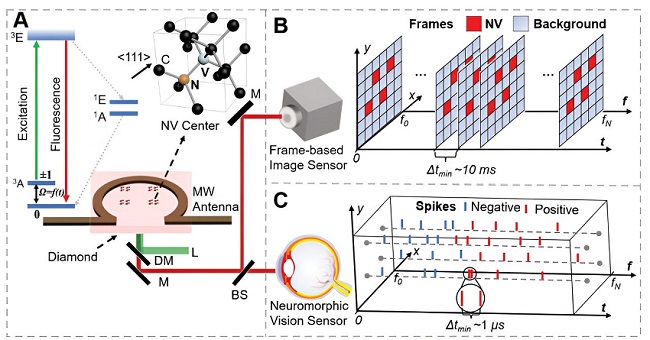DOMINIC V. ACQUISTA, DEPARTMENTS EDITOR
Collaborating researchers from Hong Kong, China, and Germany have developed a quantum-sensing technology that encodes changes in fluorescence intensity into spikes that occur during optically detected magnetic resonance (ODMR) measurements. The image capture technology uses a neuromorphic vision sensor designed to mimic the human vision system.
According to the researchers, the sensing mechanism is more efficient than traditional methods, which, they said, are commonly limited in terms of frame rate and dynamic range, among other aspects. The proposed system delivers highly compressed data volumes and reduced latency by enabling enhanced sensitivity and temporal resolution — all using an off-the-shelf event camera.

An overview comparing frame-based image sensors to a proposed neuromorphic vision sensor. (a) An energy level diagram and atomic structure of neuromorphic vision centers, as well as the experimental apparatus of a widefield quantum diamond microscope. (b) The working principle of frame-based widefield quantum sensing, where a series of frames are output from a frame-based sensor recording both fluorescence intensity and background signals. (c) The working principle of the proposed neuromorphic widefield quantum sensing, where the fluorescence changes are converted into sparse spikes through a neuromorphic vision sensor. Courtesy of Advanced Science, doi: 10.1002/advs.202304355.
According to Zhiyuan Du, first author of the study and Ph.D. candidate in the department of electrical and electronic engineering at the University of Hong Kong, methods to improve the measurement accuracy and spatiotemporal resolution of camera sensors have been areas of focus for researchers globally for many years. A fundamental challenge, he said, is handling the massive amount of data in the form of image frames. This data must be transferred from the camera sensors and processed further to ensure optimal levels of accuracy.
"This data transfer can significantly limit the temporal resolution, which is typically no more than 100 fps due to the use of frame-based image sensors,” Du said of the researcher’s efforts to overcome this bottleneck.
The researchers combined the power of quantum sensing with the adaptability and processing capabilities of modern memory devices. Unlike traditional sensors that record light intensity levels, neuromorphic vision sensors process the light intensity change into "spikes" — similar to biological vision systems. This leads to improved temporal resolution and dynamic range values. This approach, the researchers said, is particularly effective in scenarios where image changes are infrequent, such as object tracking and autonomous vehicles, as it eliminates redundant static background signals.
Using the event camera, the researchers demonstrated a 13× improvement in temporal resolution, with comparable precision in detecting ODMR resonance frequencies with the state-of-the-art highly specialized frame-based approach. They then deployed the technology to monitor dynamically modulated laser heating of gold nanoparticles coated on a diamond surface.
Beyond their favorable results, the researchers said that the work opens an avenue for the technique of diamond quantum sensing.
The researchers believe that the quantum-sensing technology, with memory device integration, could be used for biomedical and industrial applications, including monitoring dynamic processes in biological systems. They added that the quantum sensor could be used along with its high temporal resolution to monitor the dynamic processes of cellular environments, including cellular signaling, thermal activities, and mechanical interactions.
Further, the researchers believe that the high temporal resolution approach can be used to monitor electromagnetic defects in the fabrication of electronic devices, such as chips. This would enable real-time detection and analysis of issues that may arise during the manufacturing process, ultimately leading to improved quality control and enhanced performance of the final products.
The research was published in Advanced Science (www.doi.org/10.1002/advs.202304355).